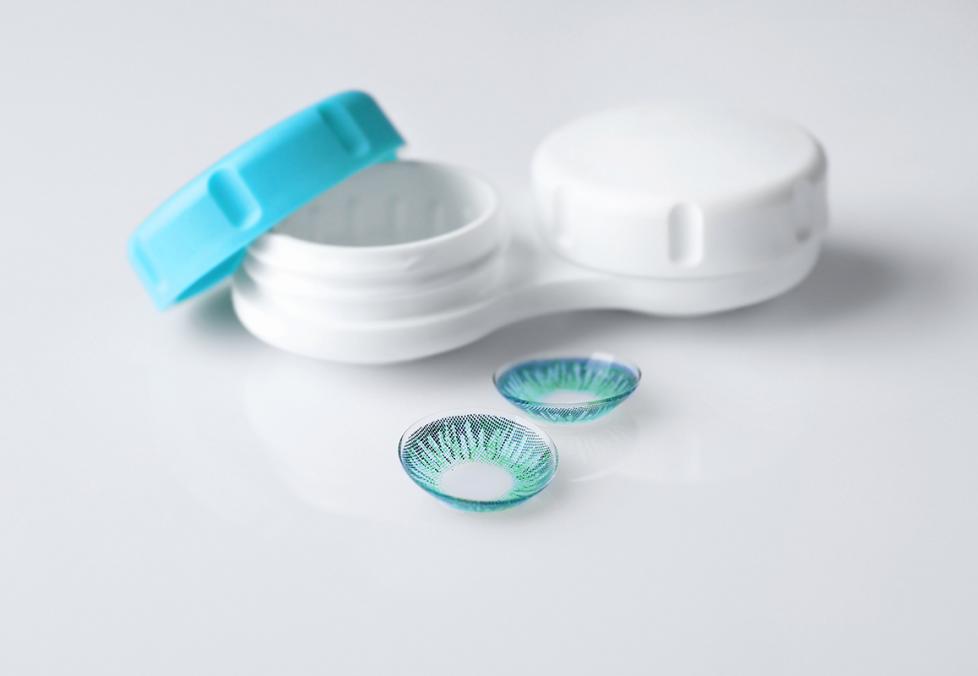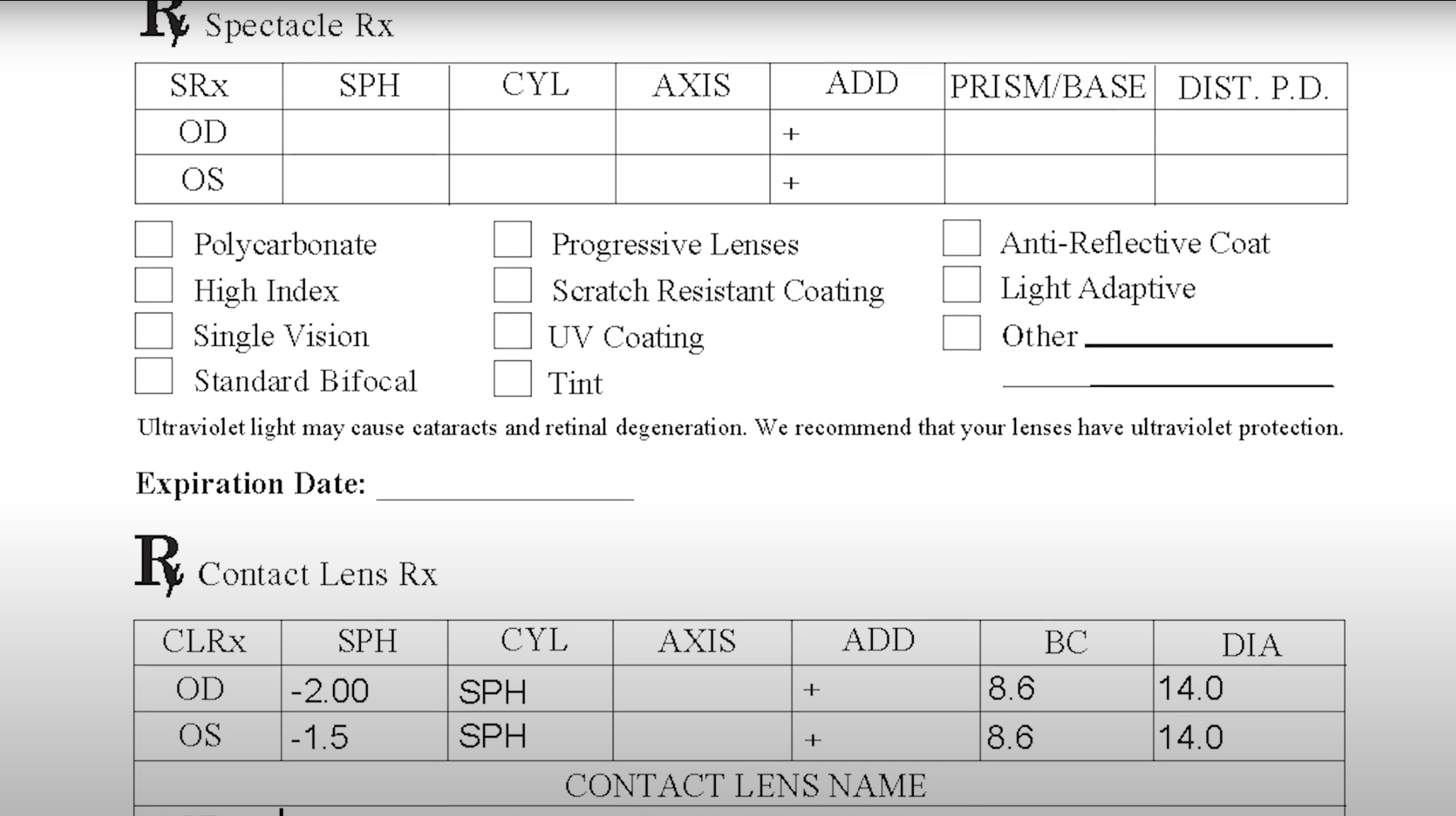
Now’s the perfect time to book an eye exam, shop for new glasses, or stock up on contact lenses.
Everything you need to know to take care of your eyes — for life.
The prescriptions you get for your eyeglasses and contact lenses may be slightly different. Here’s why — plus tips that will make reading your contact lens prescription easier.

The end goal of wearing contact lenses and eyeglasses is the same: to get as close to 20/20 vision as possible. But each device requires a different prescription to get there.
Confused?
Don’t be. The reason each type of eyewear needs a different prescription is simply that eyeglasses rest on your nose, farther from your eye, while contact lenses sit directly on the eye. That small difference in distance makes a big — and important — difference in the prescription your eye doctor writes.
Contact lens wearers: Use this easy guide to better understand the numbers and abbreviations that eye doctors use.
And for help understanding your eyeglasses prescription, click here.
Did you know that contact lens prescriptions need to be renewed every year? Find an exam time that fits your schedule.
Even if you plan to order contact lenses directly from your provider, you should always get a copy of your prescription, which you are entitled to by law.
Sure, it’s easy to let the optical experts handle the details. But it’s actually really useful to know what the terms and numbers on your prescription mean, because they help you understand exactly what’s going on with your eyes.
Your eye doctor will include specifics about:
All this information together ensures that you will have contact lenses that help you see your best.
And from a practical standpoint, it will be good for you to know the prescription strength needed for each eye, so you don’t get your lenses mixed up when it’s time to put them in.
Yes. Depending on your state’s laws, prescriptions for contact lenses last one to two years. You’ll find the expiration date on the prescription.
Once your prescription has expired, you must get a new one. It may seem like a pain, but it is in the best interest of your eye health to ensure that you have the proper prescription for your contact lenses.
Your eye doctor needs to make sure that the lenses still fit and that your eyes are healthy enough to keep wearing them.
This yearly exam is also a good time for you to ask questions about your eye health and even discuss different contact lens options that you may have heard about.
Most contact lens prescriptions include a grid or table. The combination of numbers and letters in the grid correspond to different parts of your prescription.
Here’s an example of what a contact lens prescription from America’s Best looks like. Keep reading to learn about what everything means.

These are the things you’ll see on almost every contact lens prescription:
OS: “Ocular sinister,” which is Latin for the left eye.
OD: “Ocular dexter,” which is Latin for the right eye.
OU: If you have “ocular uterque,” then the prescription is the same measurement in both eyes.
BC: This stands for “base curve.” It is the back curvature of your contact lens, measured in millimeters.
Your prescription will match the curvature of your cornea for the ideal fit and health of your eye. The lower the number, the steeper the curve is in your cornea.
DIA: This stands for “diameter.” It’s the distance from one edge of your contact lens to the other.
This is also measured in millimeters. It determines where the edges of the lens will rest on your eye. A correct measurement here ensures a proper fit of the contact lens to the surface of the eye.
SPH: This stands for “sphere,” and it refers to the strength, or power, of your prescription. (Some prescriptions may list this as “PWR.”)
This number stands for the power of vision correction you need in diopters. A negative number corresponds to nearsightedness (myopia), while a positive number corresponds to farsightedness (hyperopia).
Tip: If you also wear eyeglasses, this value will likely be different on that prescription.
BRAND: This is the manufacturer’s name of the contact lens that your eye doctor has prescribed. Each contact lens has different features and measurements.
You can only order the lenses that your eye doctor has prescribed. If you have questions about other options, ask your eye doctor during your contact lens exam.

Now’s the perfect time to book an eye exam, shop for new glasses, or stock up on contact lenses.
If you have astigmatism in one or both eyes, these abbreviations will also appear on your prescription for toric contact lenses.
CYL: This stands for “cylinder.” Measured in diopters, the cylinder shows the extent of your astigmatism.
AXIS: This isn’t short for anything — it just refers to the axis. The axis is measured in degrees (between 0 and 180). It is used to compensate for the oval shape of the cornea. It tells you where the astigmatism is located and how it is oriented on your eye.
If you have presbyopia and are a good candidate for bifocal or multifocal contact lenses, these abbreviations will also appear on your contact lens prescription.
ADD: This stands for “add power,” referring to the lower part of bifocal and multifocal lenses. It will help you see better up close. The add power is measured in diopters.
If you’re getting lenses that change or enhance the color of your eyes, you’ll also see this on your prescription:
COLOR: In the case of a special effect, a particular design is written here. Color and style names vary by brand.
Press play on the video below for more tips to help you understand your contact lens prescription. And remember to always consult your eye doctor with any specific questions you have about your contact lenses or other eye health concerns.
Recommended reading: America’s Best Guide to Contact Lenses